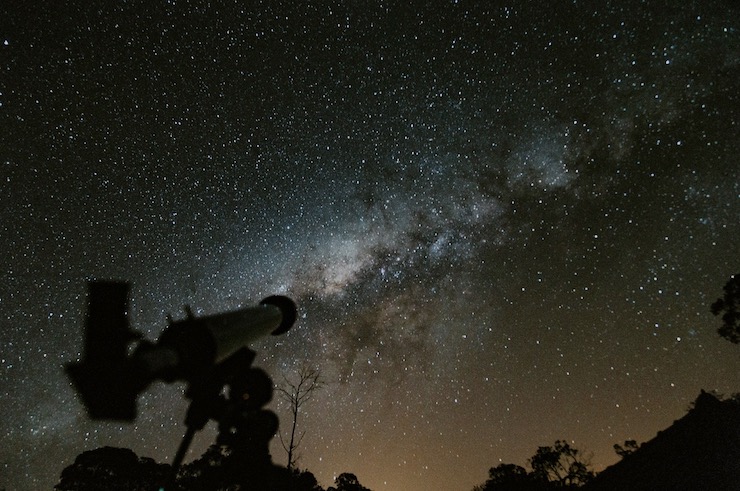
When looking up to the night sky, the universe can seem to go on forever. It is so vast that instead of measuring in miles it is measured in light-years. From what is observable, cosmologists estimate the universe to reach 93 billion light-years. There is still so much to be learned about the wonders of the universe. One big question that scientists have been looking at is the force of dark matter, or energy, found in the universe. Because dark matter does not interact with the electromagnetic field, it is very hard to detect. This mysterious force is responsible for the expansion of the universe and how it affects gravitational forces. Still, scientists believe that dark matter makes up about 85% of the universe’s total matter.
The motto of the Wright Laboratory at Yale University in New Haven, CT is “Exploring the Invisible Universe”. Within the Wright Lab is an experimental cosmology laboratory run by assistant professor Laura Newburgh, aptly called the Newburgh Lab. Newburgh and her students use a range of telescopes to measure cosmic history to research dark matter. Recently, Newburgh had the opportunity to run some experiments using drones to help calibrate telescopes used to measure dark matter in Suffolk County, NY at the Brookhaven National Laboratory (BNL). A branch of the U.S. Department of Energy and managed by Stony Brook University, BNL is home to the Baryon Mapping Experiment (BMX). This prototype radio telescope was built in 2017 to examine how radio interference can be minimized and to test calibration techniques. The tests performed with BMX will ultimately lead to the development of larger more powerful telescopes. BMX is also used to map neutral hydrogen throughout the universe, supplying data on dark matter and universal expansion.
Since dark matter is so difficult to measure, having perfectly calibrated machines to detect it is critical, otherwise to much time and effort will be wasted. Traditionally, radio telescopes use sensitivity to focus onto a point of interest. The teams from the Newburgh Lab and BNL are looking to use radio waves to fine tune the way these multi dished telescopes are calibrated. Group leader of Cosmology and Astrophysics at BNL, Anže Slosar said, “We want to know exactly what the telescope sees with the accuracy of one part in a thousand, or better. Eventually, we would propose building a telescope with thousands of dishes, but the calibration method would be the same. So, if we can show that we calibrated the prototype to the right precision, then we know we can do that for a larger telescope as well.” And this is where drones can assist.
This past March, before COVID-19 related restrictions took place, the two research teams came together to see just how accurately a drone could be used to test the calibration of the BMX radio telescope. To do this, Newburgh and her students brought a drone out to the BMX field site. Along with the drone’s regular camera payload was an additional small radio source. The drone was then flown over BMX through a zig-zag grid pattern, being sure to cover the telescope’s field of view in entirety. As the drone flew over the telescope the radio transmitted a signal to be intercepted by the telescope.
As Emily Kuhn, one of Newburgh’s graduate students pointed out, this method of calibrating telescopes is not new, in fact, it’s a system that has been in use for about 10 years. However, in the past, it has been hard to get precise results because recording the exact point of location of the drone on a grid over a telescope can been misleading. “We solved this problem by using a differential GPS (DGPS),” Emily said. While traditional GPS can give locational information, a higher degree of accuracy is needed when calibrating a telescope used to measure dark energy. Rather than measuring down to a meter with standard GPS, DGPS can measure a location to within a centimeter.
With the use of the drone, both teams were able to test BMX’s calibration in great detail. As Newburgh said, “Drone-based calibrators solve many problems in calibrating 21 cm stationary telescopes, which need to be precisely calibrated in order to detect incredibly faint signals, but we can’t understand how well we’re doing unless we actually try to calibrate a telescope.” The main telescopes that the Newburgh Lab uses for research are in California and South Africa, and getting to these sites to test calibration capabilities is not ideal. On top of that, there are far too many regulations for flying drones over these sites for testing purposes. BNL provided Newburgh and her team a unique opportunity since it is only a short distance from the Wright Lab. BMX was also designed as a radio testbed, exempting it from certain drone restrictions. By using a drone to test radio calibration locally allowed Newburgh’s students to perfect their methods before traveling to their other telescope locations.
Though the collaboration between the two labs has been slowed down due to the coronavirus, tests are still ongoing. The two teams working together are giving each other valuable insight into the capabilities of both BMX and drone-based calibrators. Hopefully, when perfected, the calibrations will lend to a better understanding of dark matter and the vastness of the universe.
|